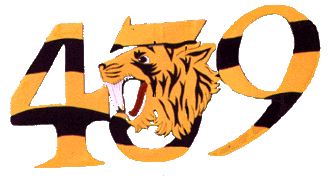|
History
of
 Squadron Squadron
  
Chapter
VI
Winter in the Netherlands
November 1944 January
1945
|
The operational history of the three winter months at Eindhoven may be summed in a few statistics. No. 439 Squadron flew 720 sorties on
(1)
up 112 operations in the course of which it dropped almost 260 tons of bombs and fired 61,514 rounds of 20 mm. ammunition. The effect of the weather may be seen by comparing these totals with those for the two previous months, September and October, when, despite periods of inactivity due to moves and weather conditions, the squadron flew 773 sorties on 1O3 operations, dropped about 275 tons and fired over 65,000 rounds.
(1) Rail attacks 32; armed reconnaissances (without bombs) 33;
Army support attacks 11; bridge attacks 4; canal attacks 2; "blind" bombing 2; weather reconnaissances 28. Most of the weather recces were also armed
recces.
Casualties, unfortunately, showed a marked increase, totalling 15 pilots missing or killed during the months November through January. The heavy haze which had settled upon Eindhoven in the last days of October continued until the late afternoon of 2 November when a weather recce was finally able to report
"oranges sweet" and eight pilots took off to resume the rail cutting campaign.
|
Intentionally
left blank
|
Intentionally
left blank
|
Two definite gaps were blown in some tracks
across the German border from Venlo, and "railway installations" in a little village were probably damaged. Three attacks were made on the 4th, despite considerable cloud, and three more cuts were made, all in Holland, at
Dieren, Windesheim (south of Zwolle), and Barneveld (east of
Amersfoort). The usual tactics on these operations were to fly parallel to the rails at about 7000 feet, then roll over in a dive to the left and release the bombs at about 2005.
The 6th was not a pleasant day due to thick cloud, a strong wind and spasmodic showers; nevertheless four attacks were carried out between 8 a.m. and 4 p.m. Three pairs of bombs cratered the rail line between Apeldoorn and
Deventer; the tracks between Goor and Delden were damaged; and large craters cut the rails in three places below
Zwolle. The fourth show was less successful. The dive on the target at
Heino, south east of Zwolle, was difficult, necessitating an aileron turn to get on the rails and as a result the bombing
was quite scattered, only the leader, W/C Grant, scoring a hit.
|
|
As F/O J.A. Brown pulled out of the attack his companions noticed that glycol was streaming from his Typhoon, possibly as the result of blast from his own bombs. They informed the pilot over the R/T and he at once set course for base, losing height steadily. Brown got as far as Deventer before he had to bail out, amid a hail of flak from that hot spot. His parachute was seen to open and some weeks later the squadron learned that he was a prisoner of war. He had
completed 77 sorties on his tour.
  
Copyright
©1998-2016 Michael T. Melnick. All rights reserved
the
unofficial homepage of  Tiger
Squadron Tiger
Squadron
.
.
|
|